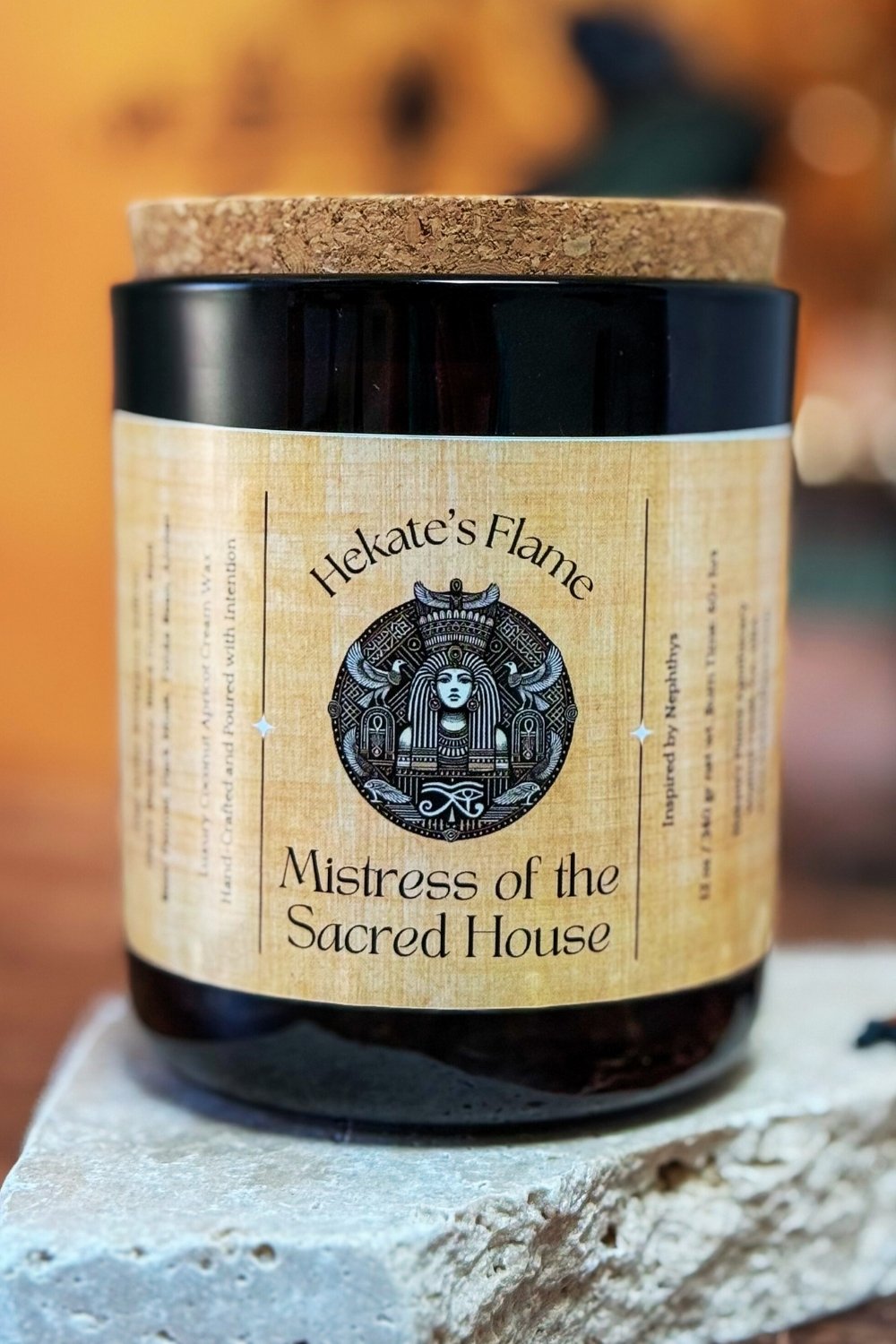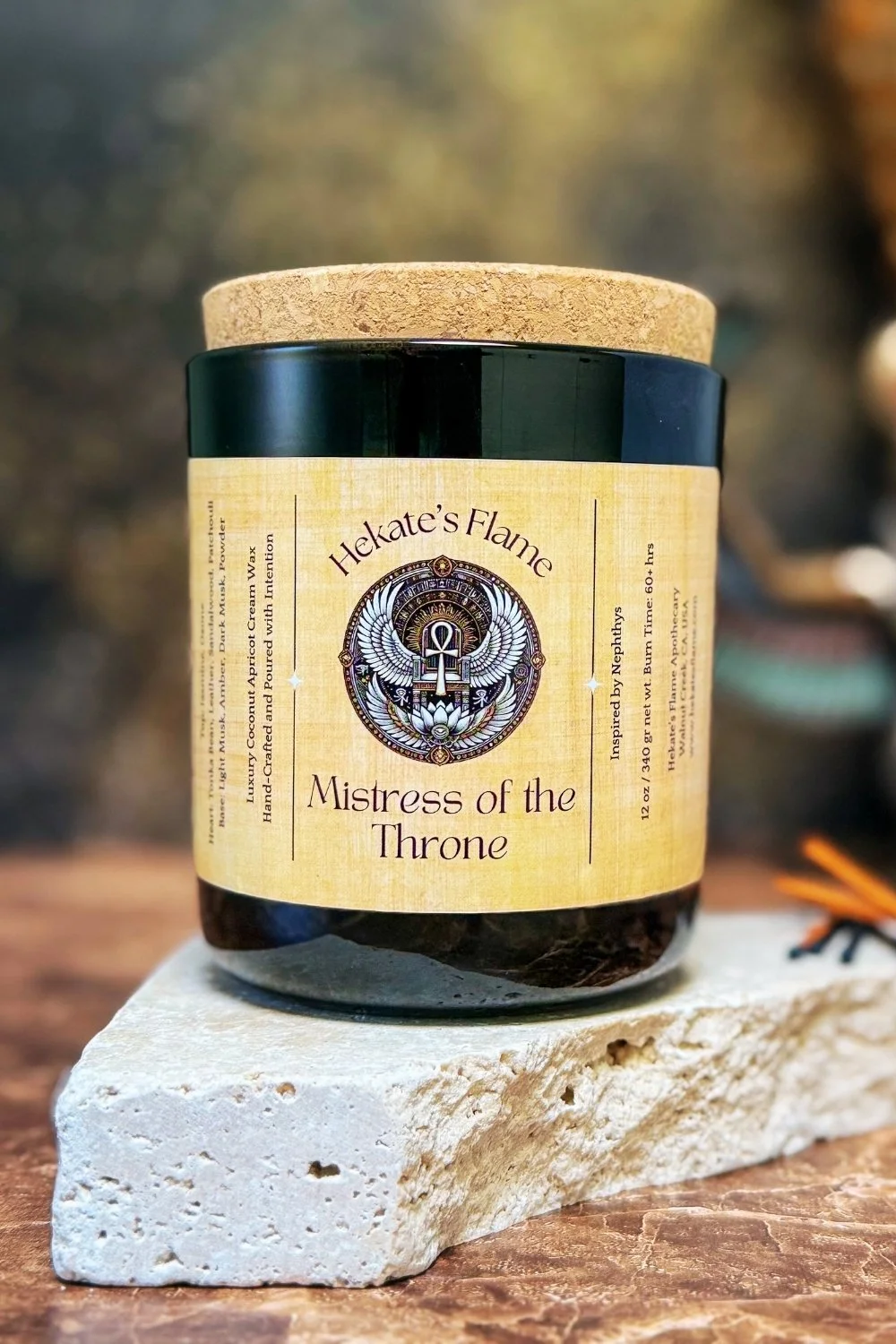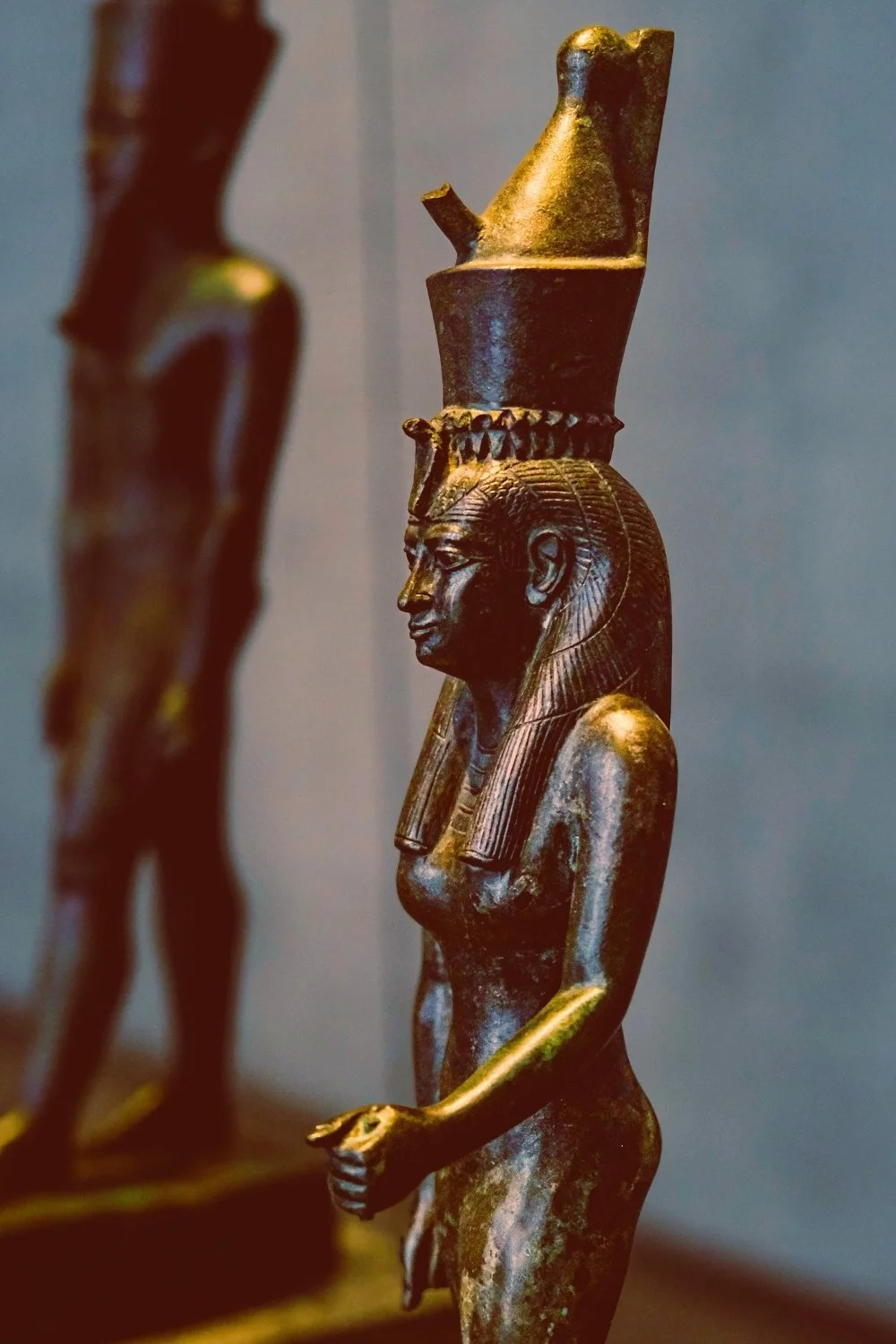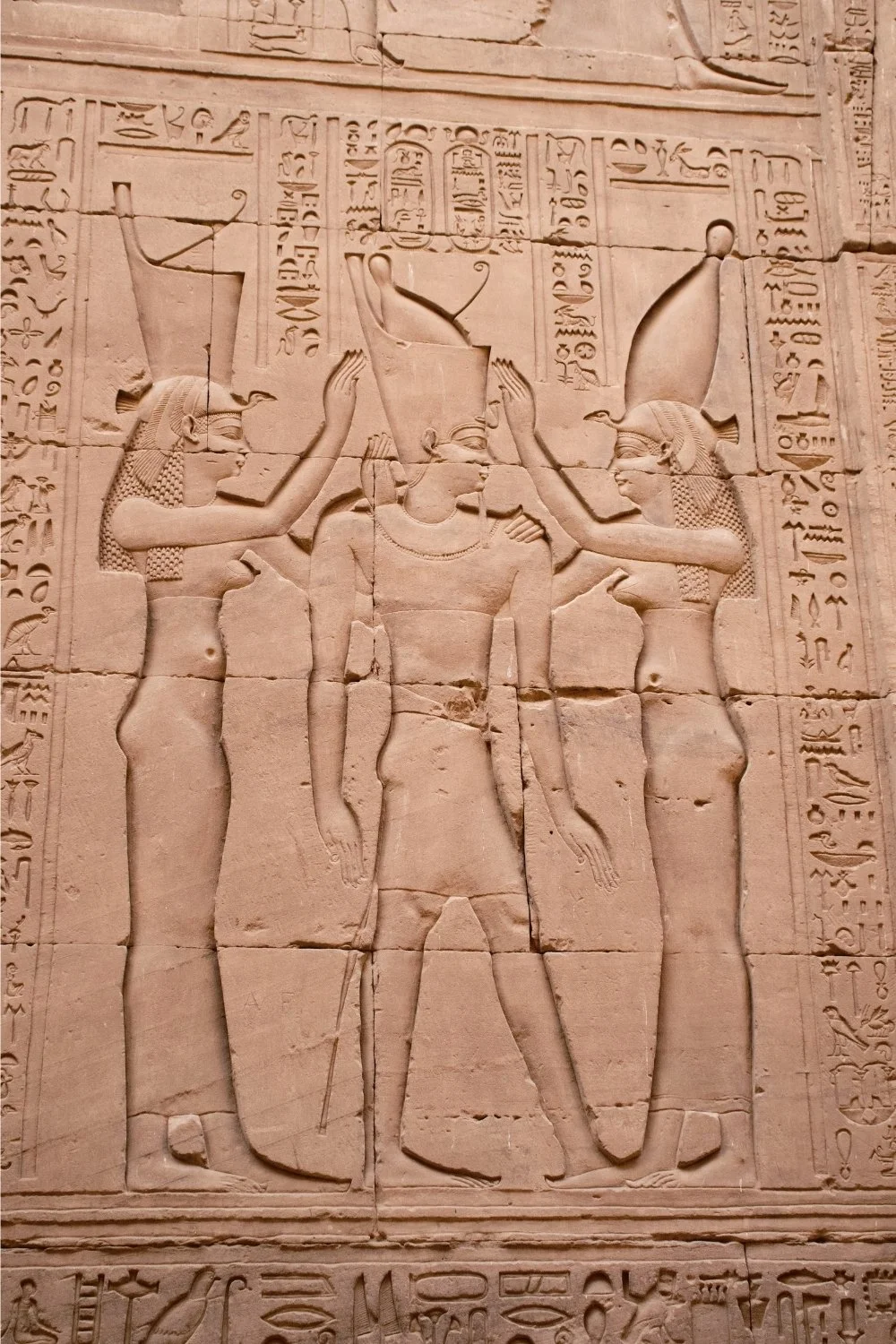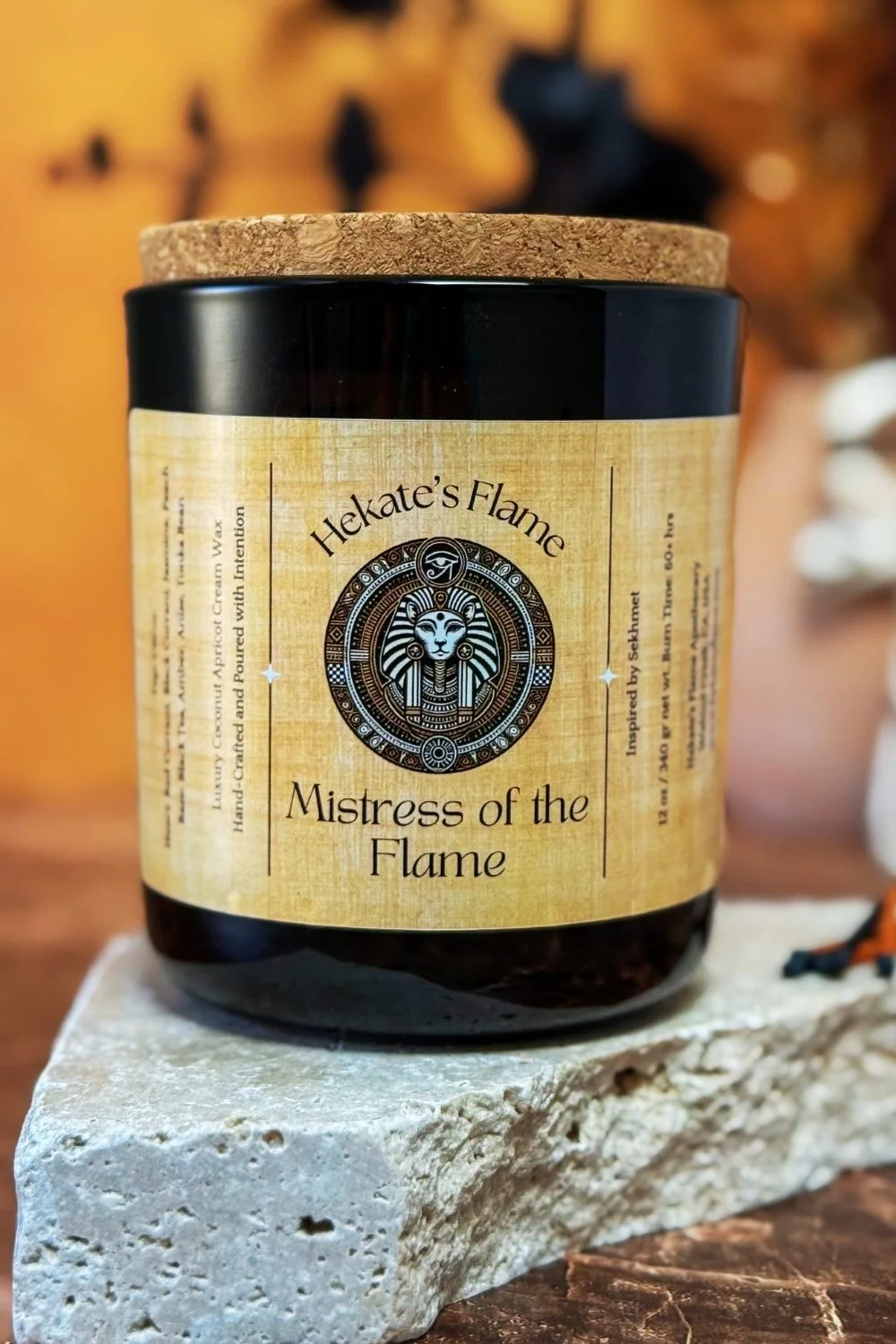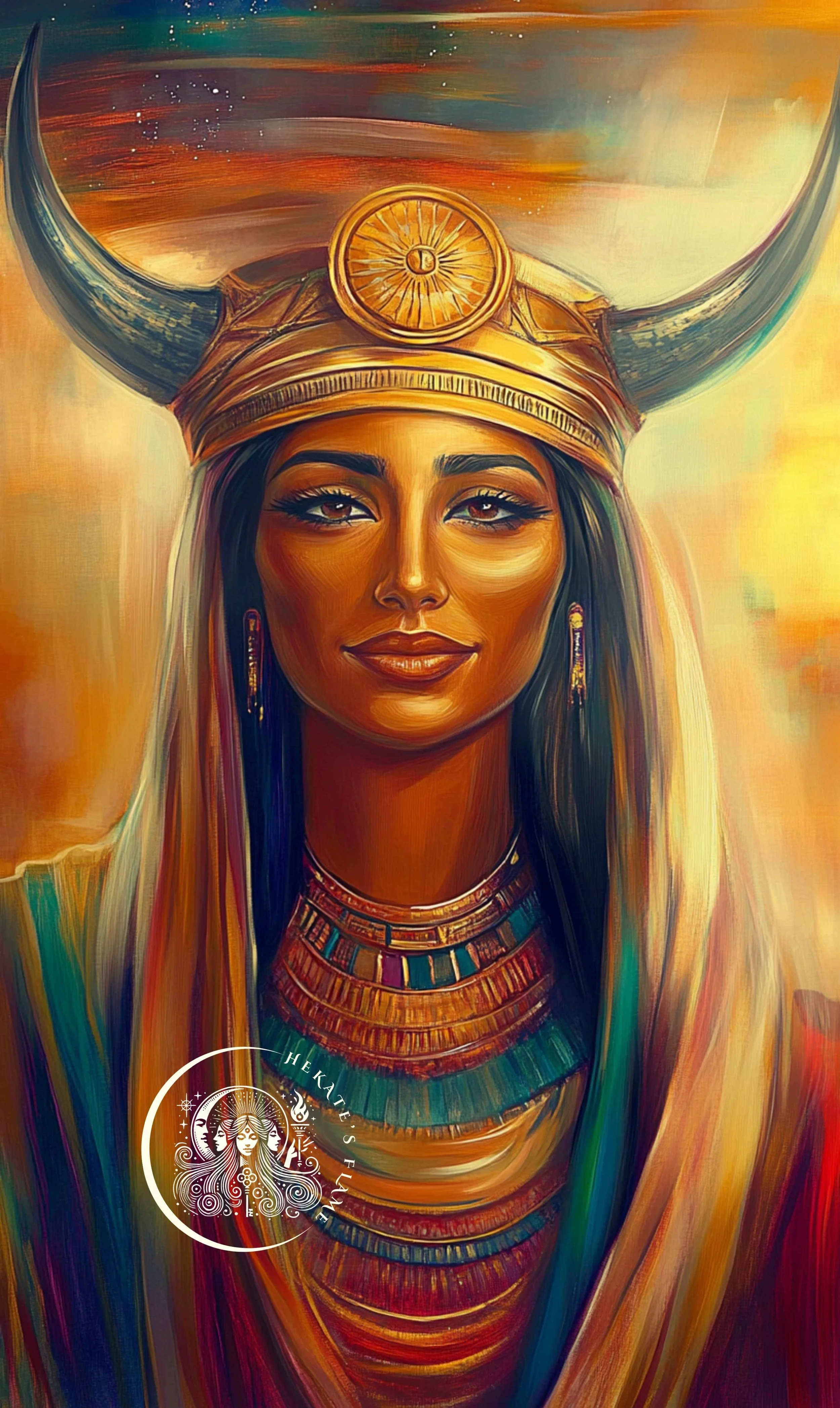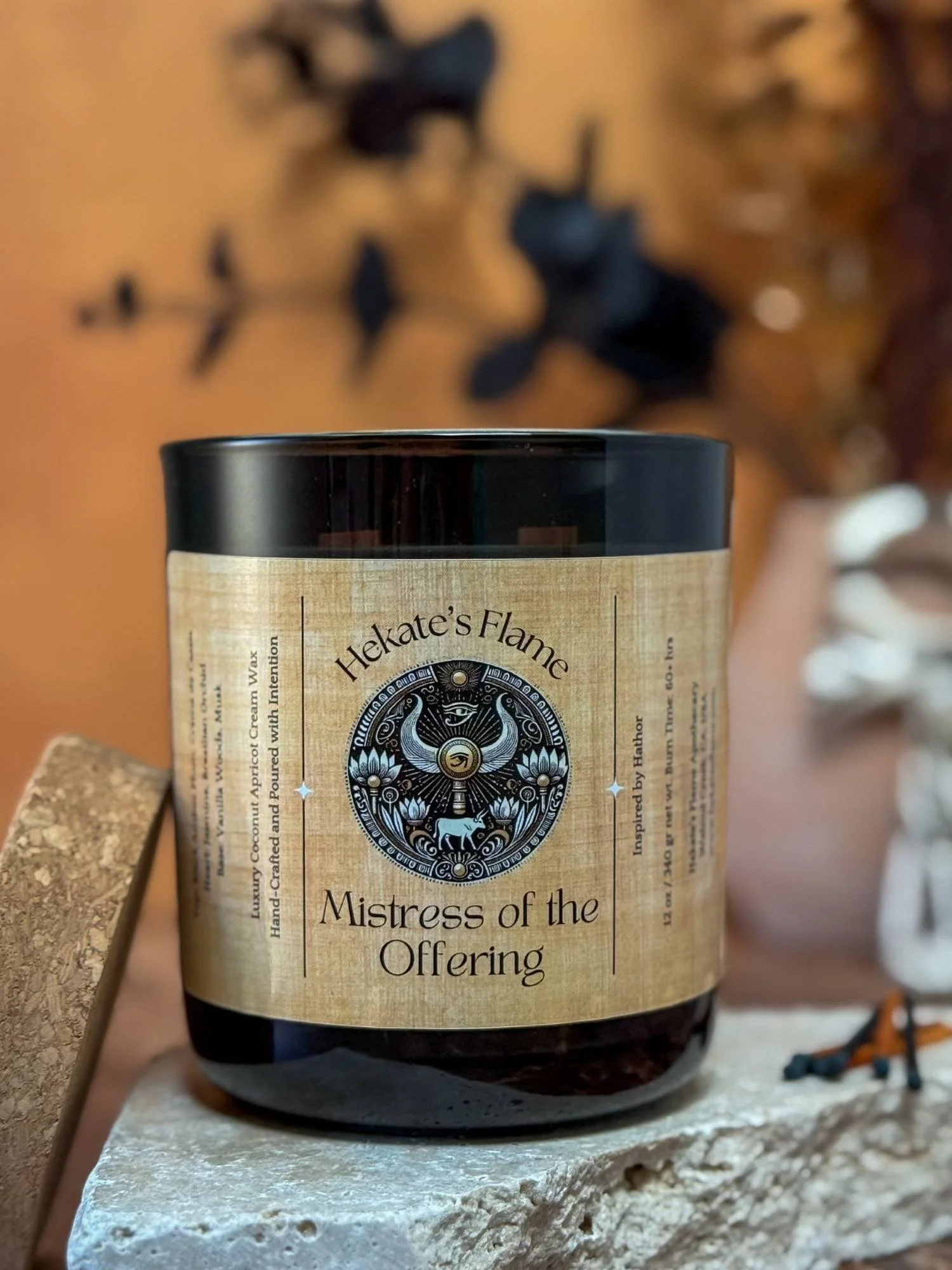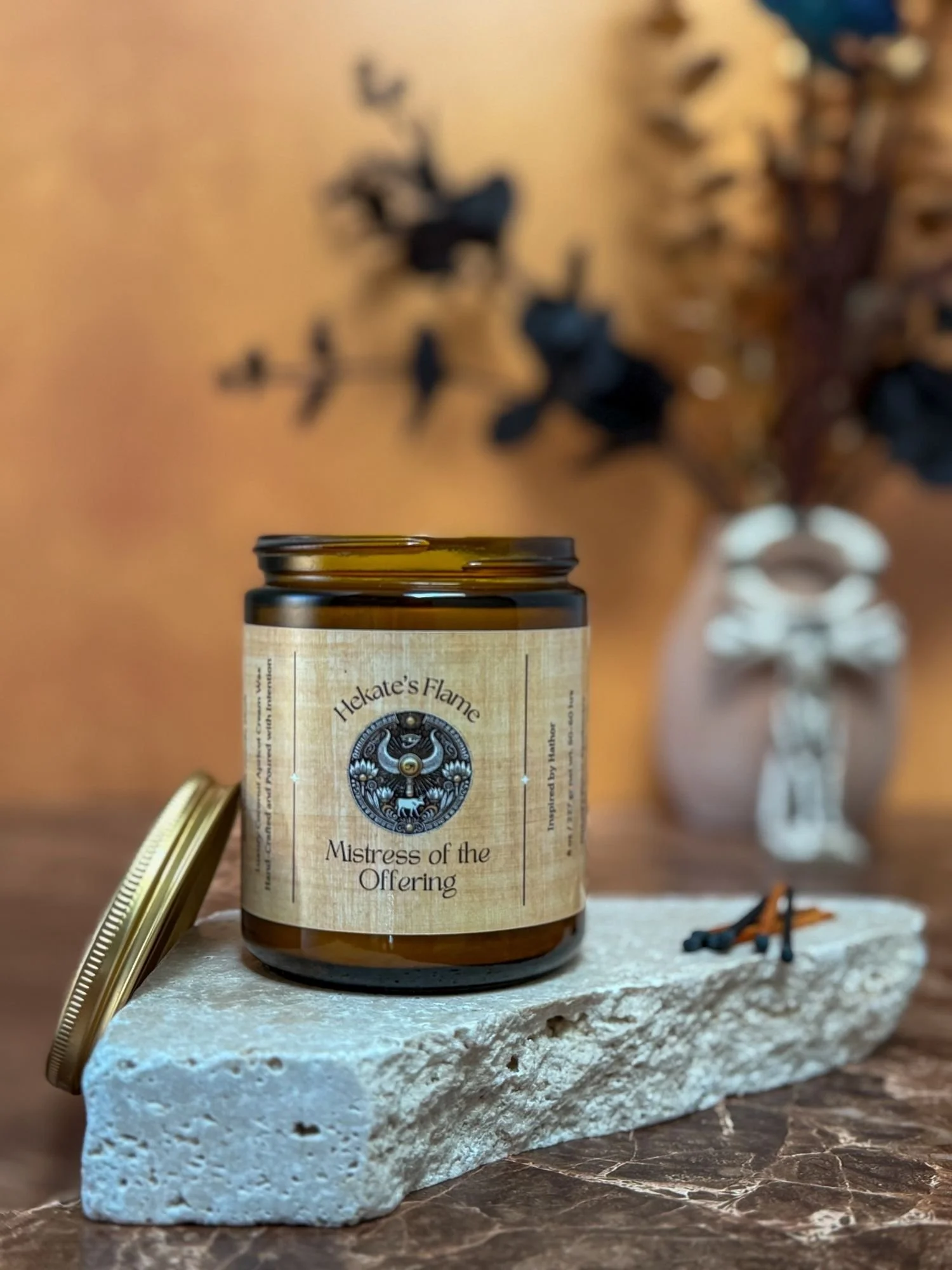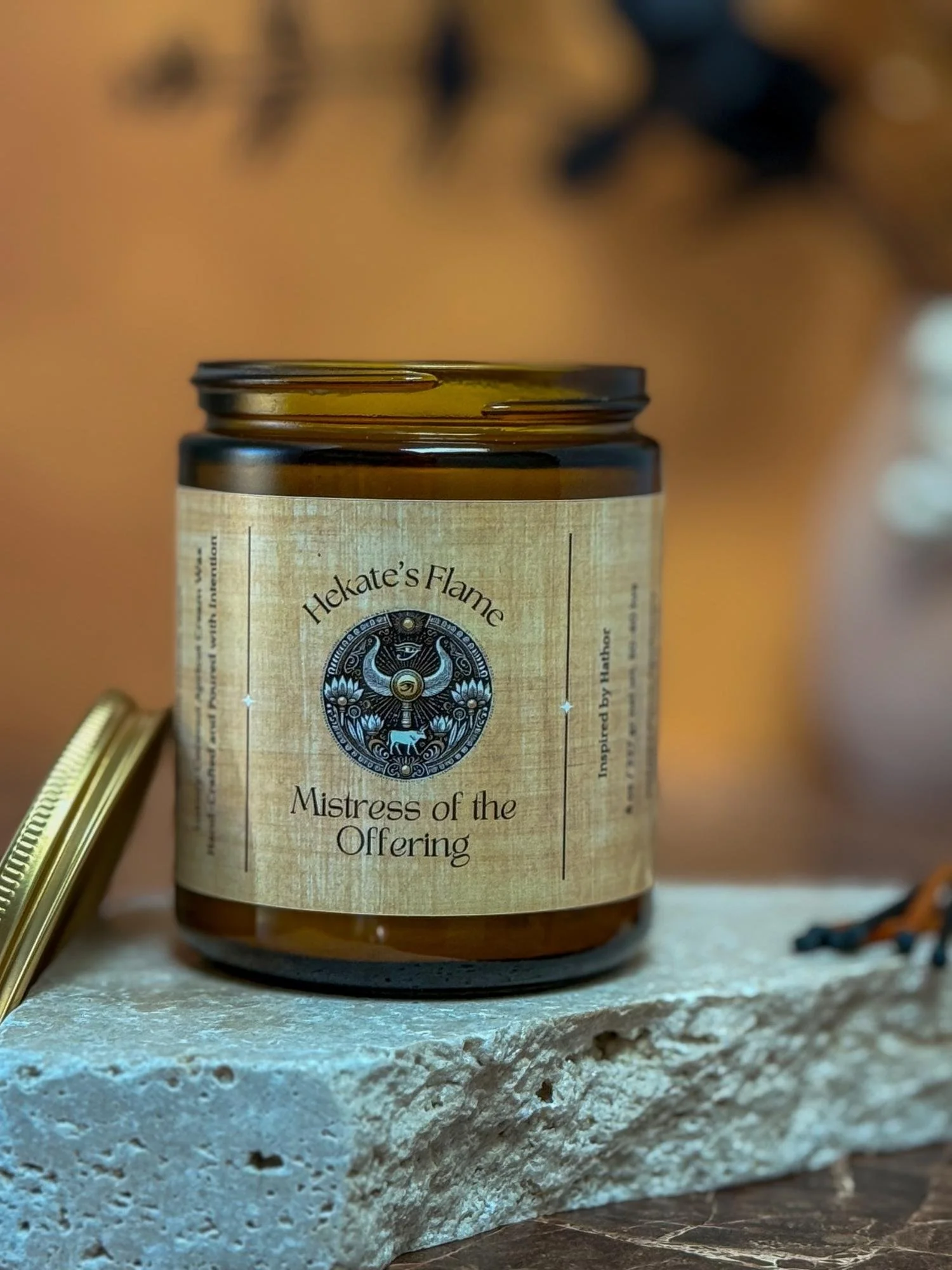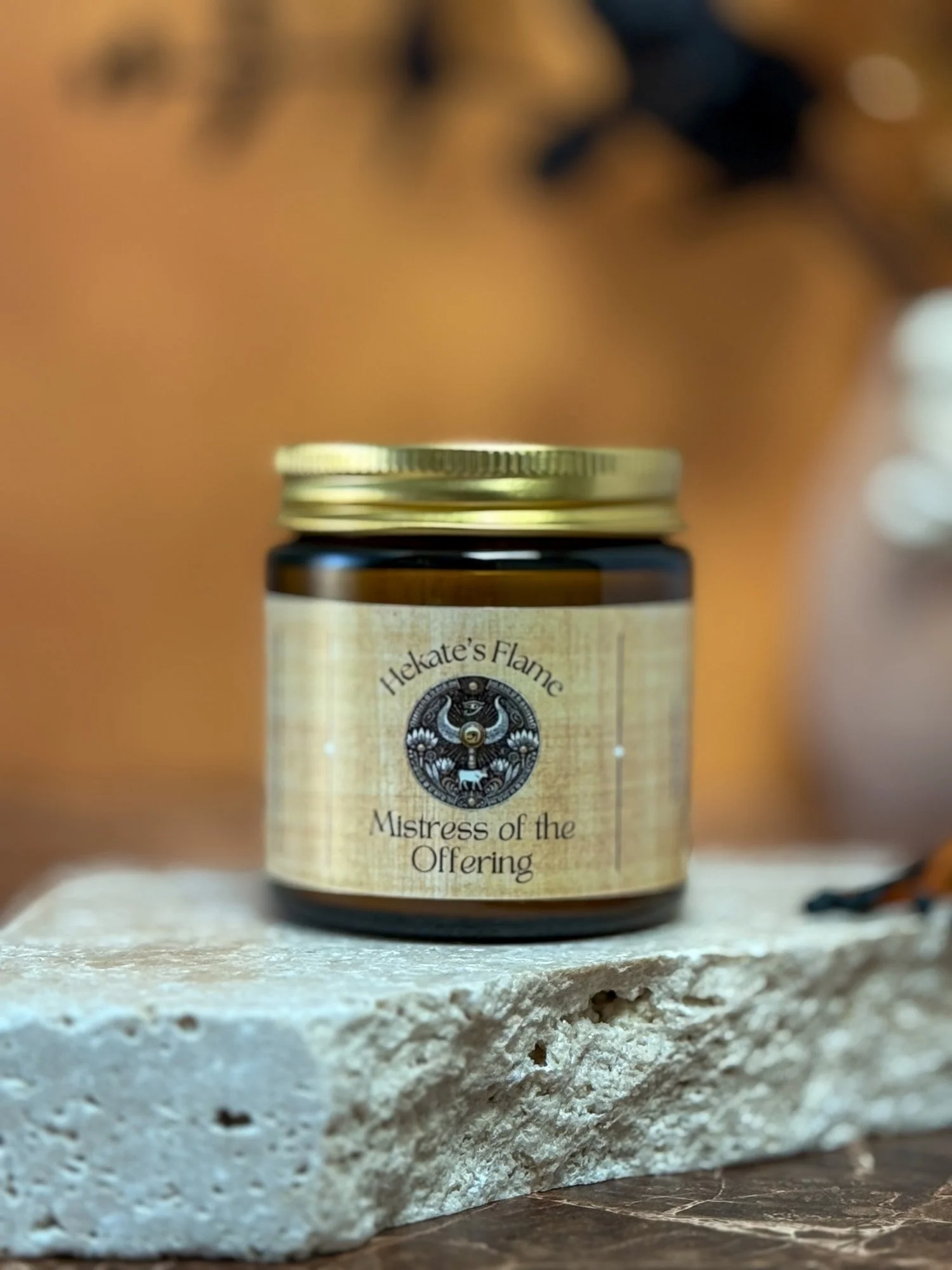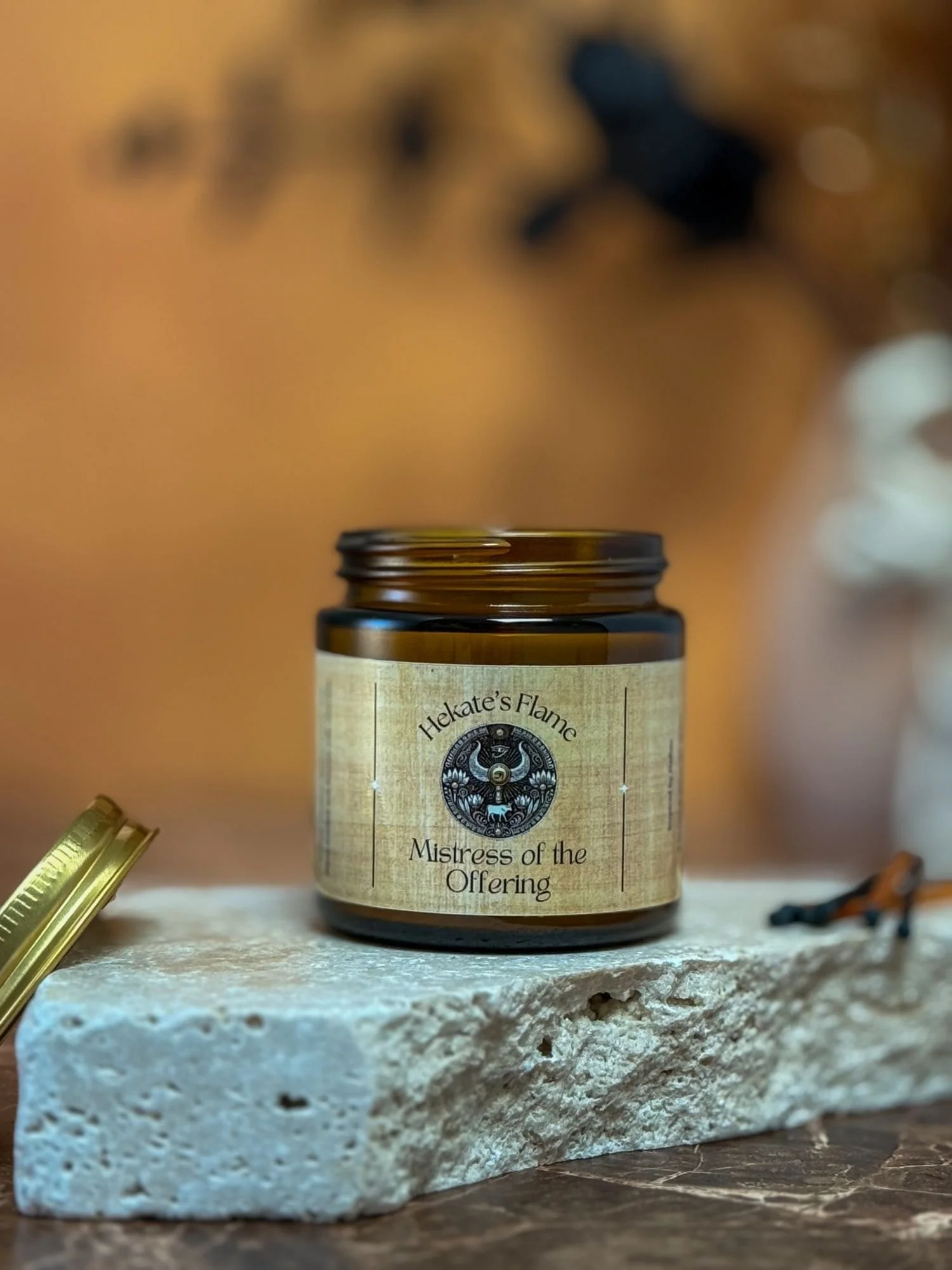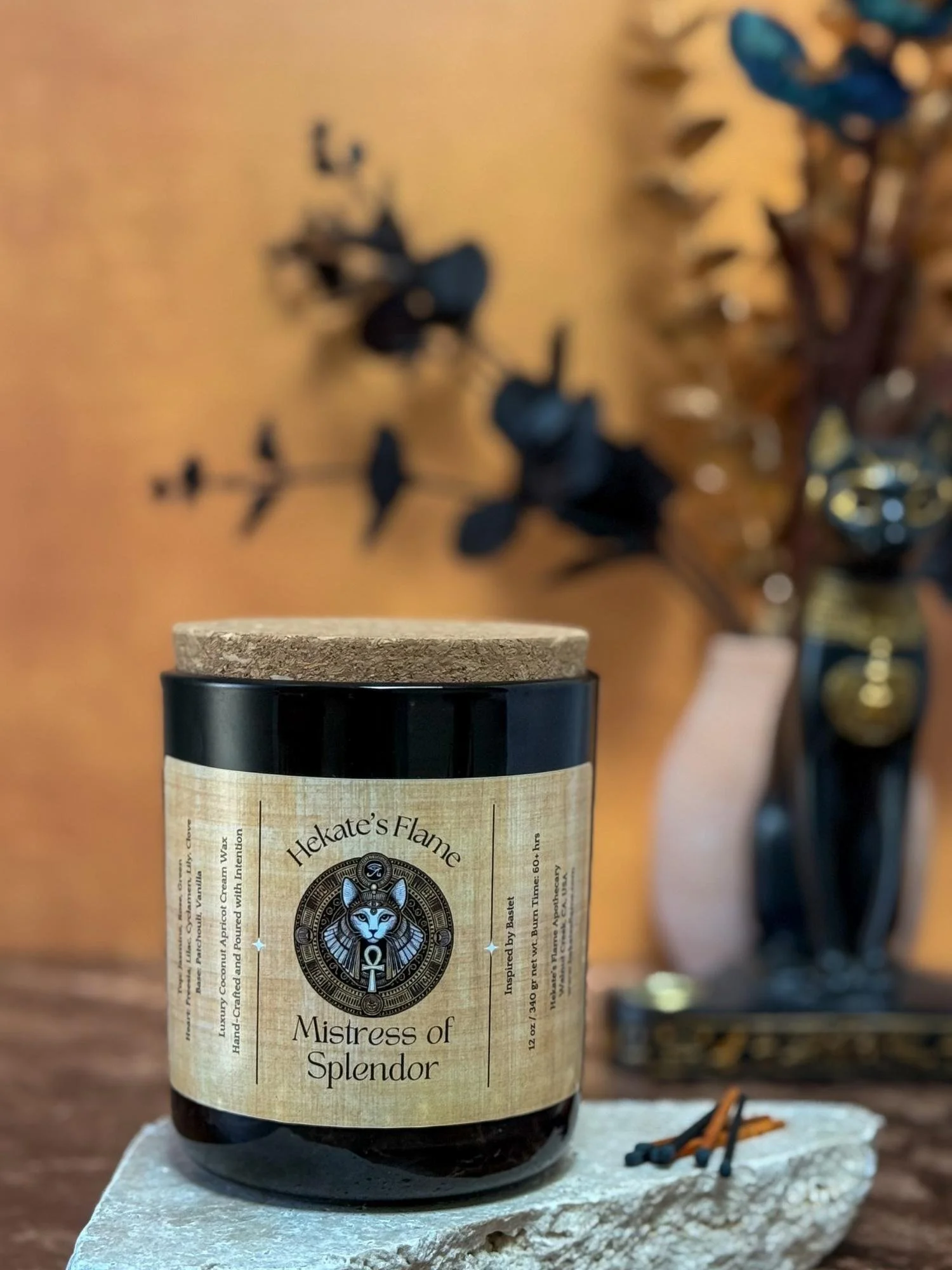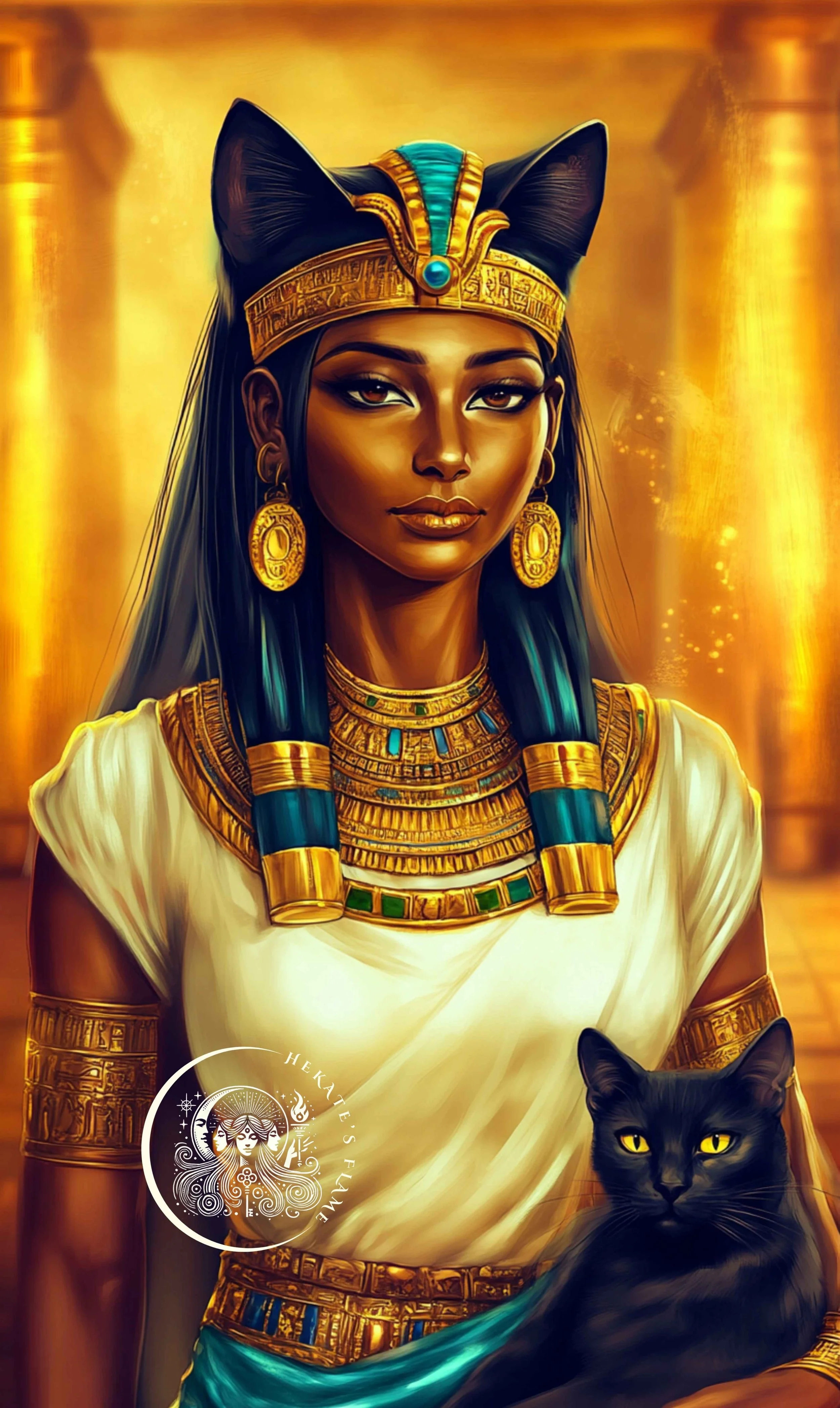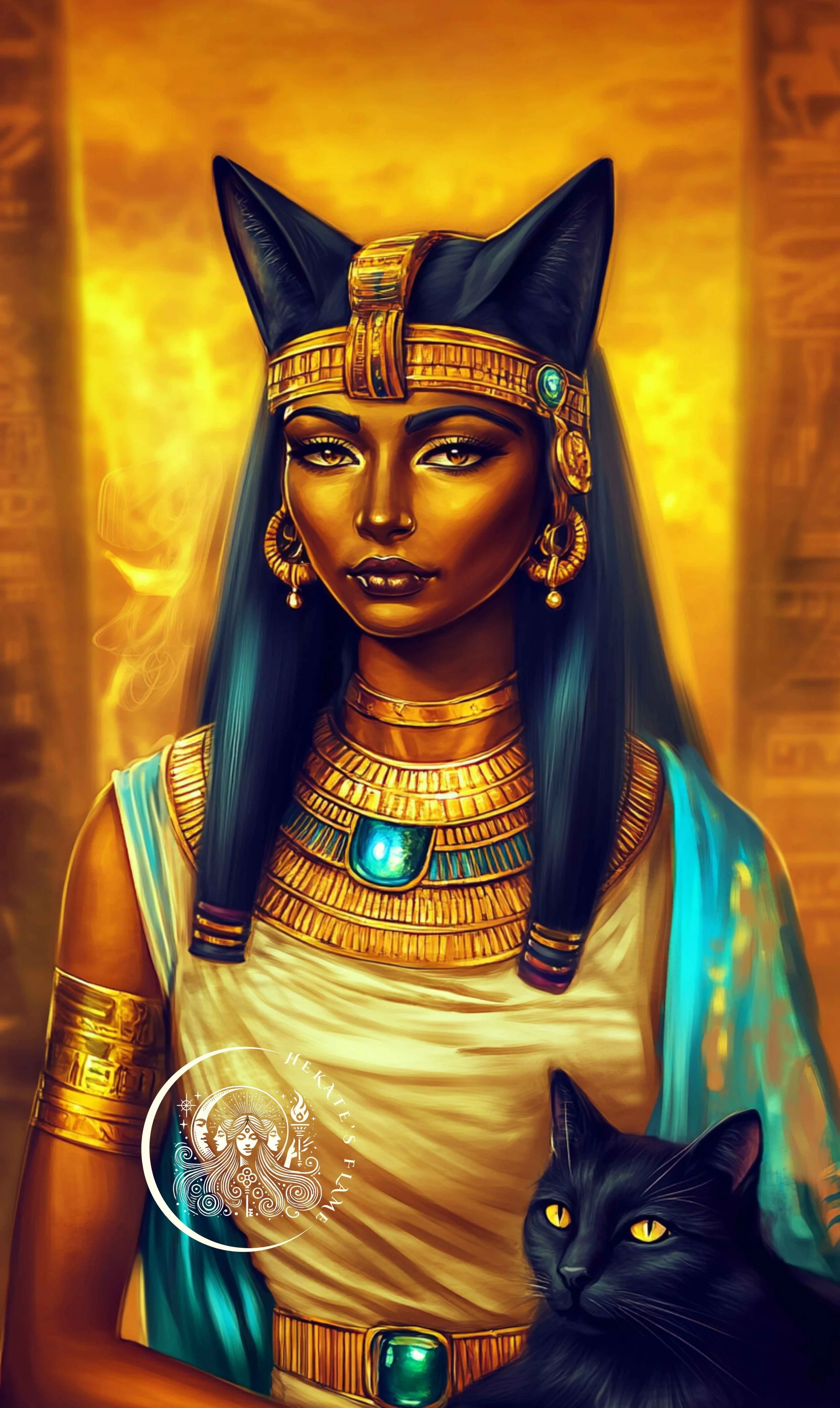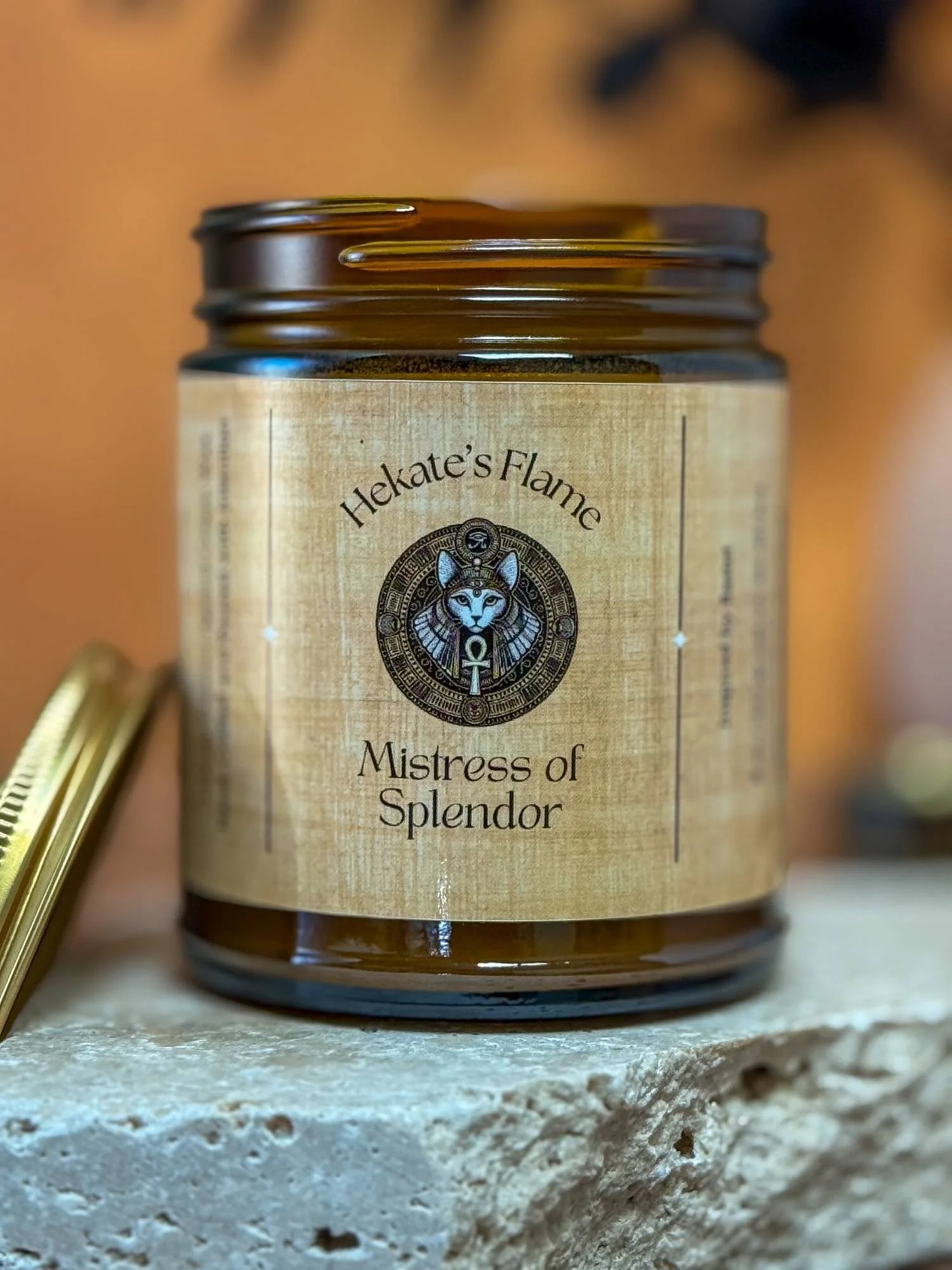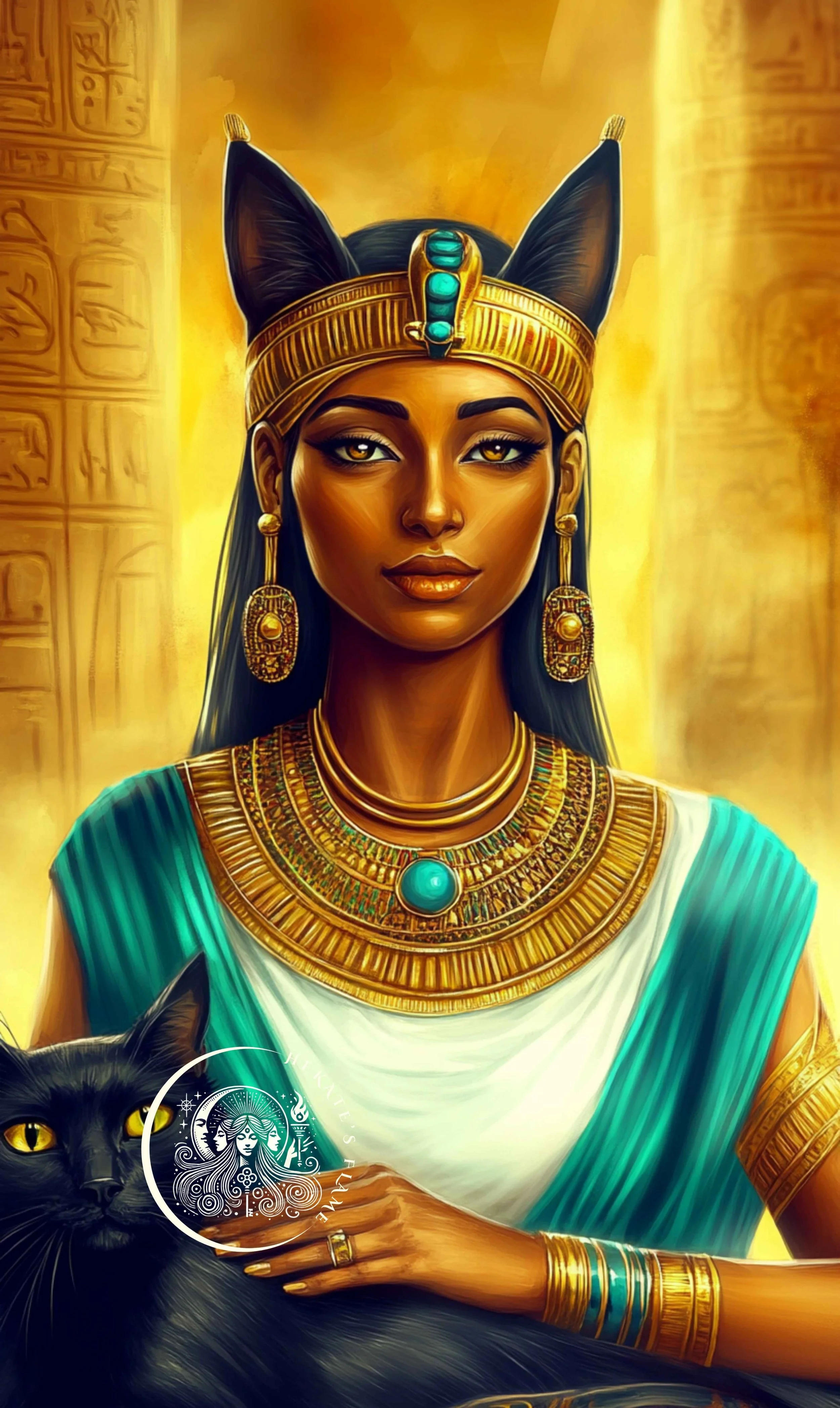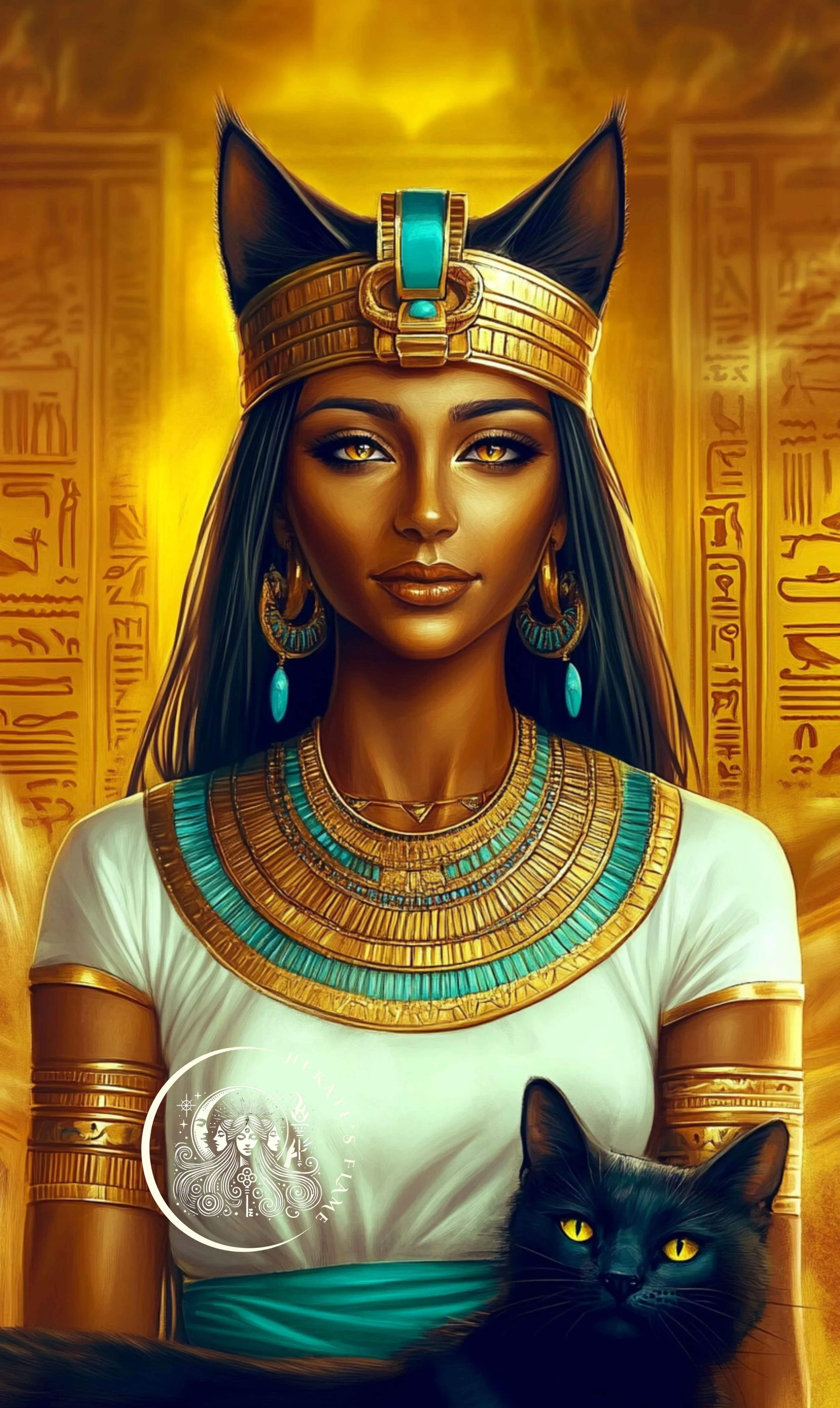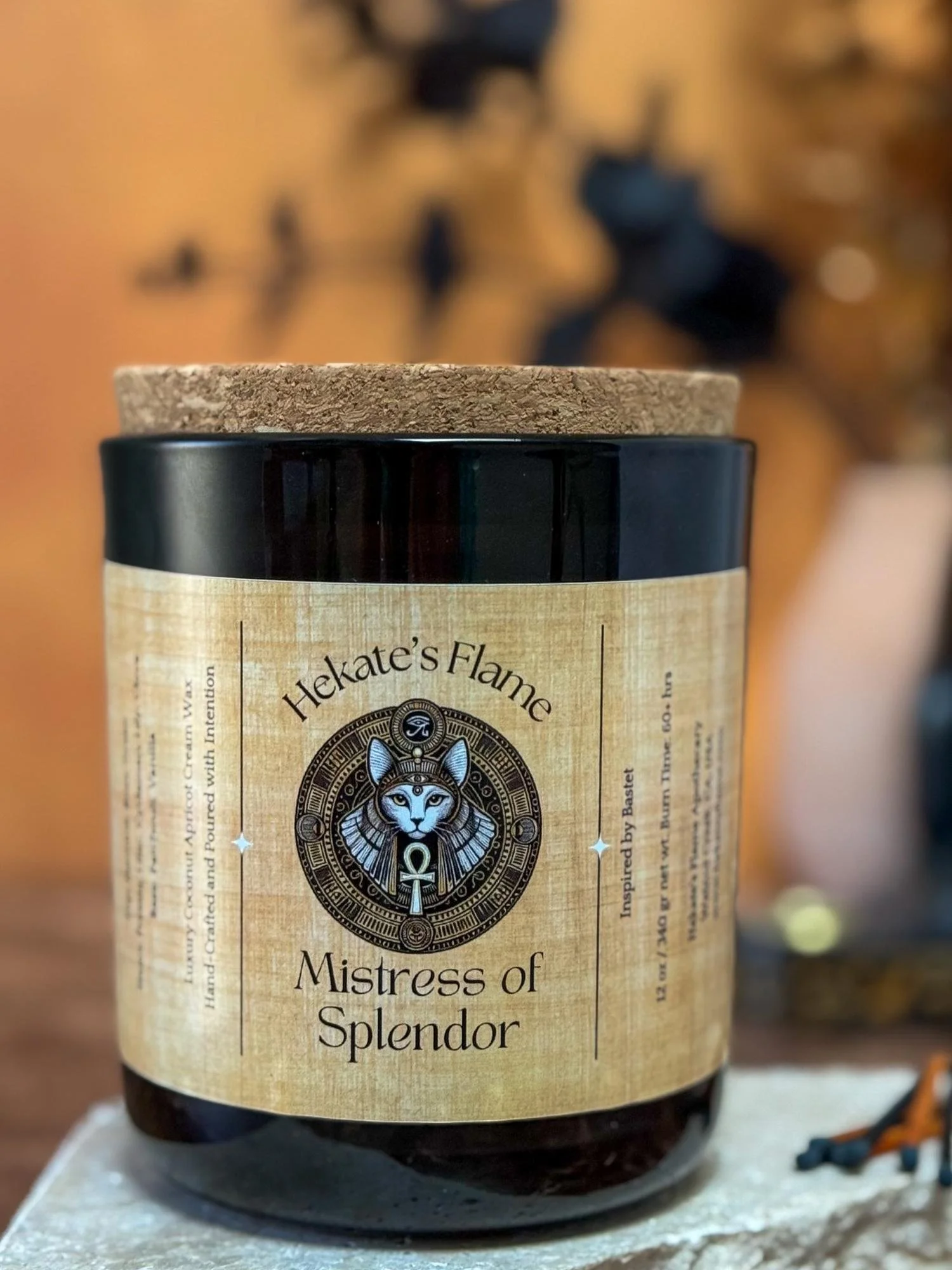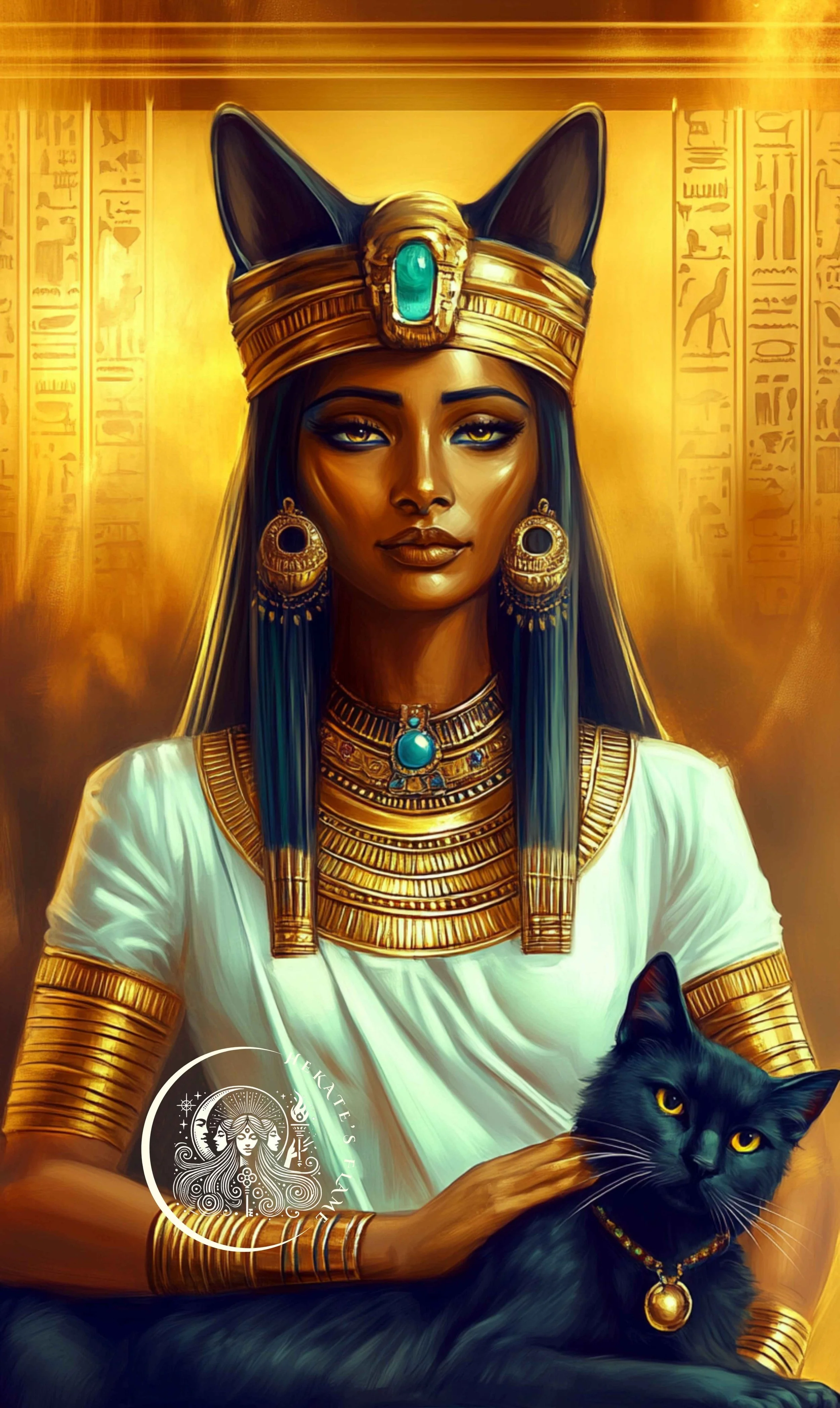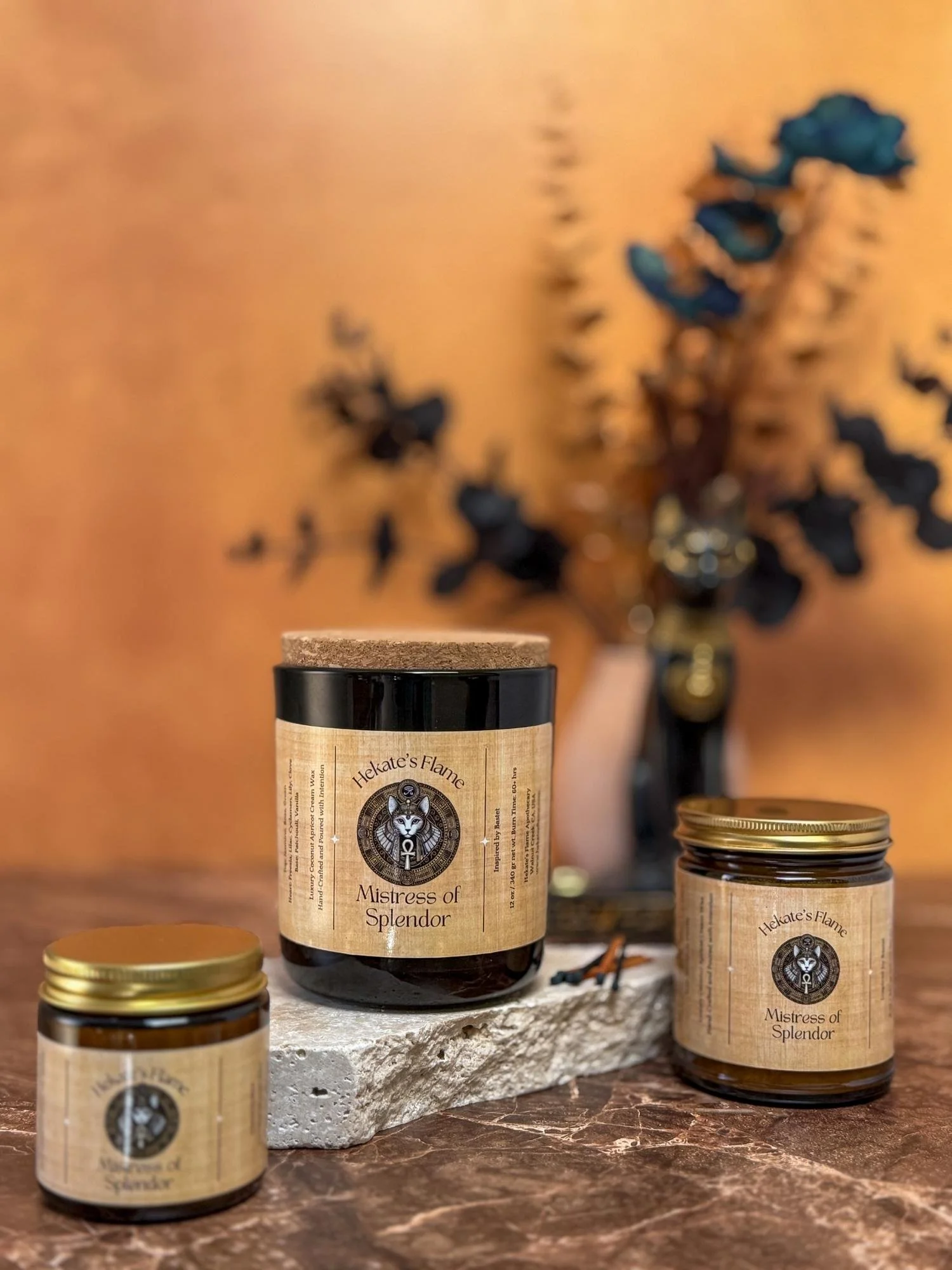‘Mistress of the Sacred House’: a handmade artisanal candle inspired by Nephthys, the Egyptian goddess of night, mourning, and sacred transitions
She who weeps with twilight and guards the sacred threshold
Imagine twilight descending over quiet stone, the air cool and heavy with memory. That is the spirit of Mistress of the Sacred House: anise, eucalyptus, and saffron bright as the first breath of dusk, blackberry, black currant, and basil deep as shadowed halls, and fennel, amber, and tonka bean warm as hidden embers. A scent of mourning and renewal, honoring Nephthys’s gentle power, the keeper of thresholds, the guardian of what is never truly lost.
Scent Notes:
Top: Anise, Eucalyptus, Saffron.
Heart: Blackberry, Black Currant, Basil.
Base: Fennel, Dark Musk, Tonka Bean, Amber.
🍂 Season Scent: Autumn
🔥 Primary Scent Family: Spicy & Warm
🌿 Secondary Scent Family: Aromatic & Herbal
Please visit this blog post for more information on Scent Profiles, Top, Heart, and Base Notes.
Our candles are lovingly handcrafted in our home studio, Nimue’s Lair, nestled in Walnut Creek, CA. Each one begins with a luxurious blend of coconut-apricot wax, carefully infused with premium fragrance oils. Poured by hand into elegant glass vessels and amber jars, they’re finished with hand-cut labels and enchanted final touches. Every candle is a small ritual, infused with magick, intention, and the quiet glow of story.
-
12 oz Deluxe – Smoke Aura Glass · Coco Apricot Wax
Burn Time: 60+ hours
Bold and enduring, this candle fills your space with myth and memory. Crafted for spacious sanctuaries, this candle shines in wide-open living rooms, high-ceilinged studios, and sacred hearths ~ places where scent is free to roam and the flame becomes a luminous companion to stillness and story.8 oz Classic – Amber Jar · Coco Apricot Wax
Burn Time: 50–60 hours
A perfect size for quiet corners and thoughtful pauses. Let it warm your reading nook, home office, or bedside altar, where its flame flickers like a whisper of intention.4 oz Petite – Amber Jar · Coco Apricot Wax
Burn Time: 20–25 hours
Small in size, rich in presence. This candle is ideal for travel, gifting, or sanctifying intimate spaces - guest rooms, personal altars, or quiet corners where scent and flame are invited to linger with intention. -
For detailed information about our waxes, wicks, fragrance blends, and vessels, please see our Ingredients & Materials Guide.
-
For guidance on how to tend your flame with care, ensuring the cleanest, safest, and most enchanting burn, please visit our Candle Care Guide.
-
Please visit the Shipping and Returns Information page for details.
-
All photographs, images, and written content on this website are original works of Hekate's Torch Apothecary, LLC (doing business as Hekate’s Flame Apothecary) and are protected by copyright. They may not be used, altered, shared, or reposted on any platform without explicit written consent. All label designs, photos, images, and content are the exclusive property of Hekate's Torch Apothecary, LLC.
For inquiries regarding the use of our content, please contact: care@hekatesflame.com
© 2025 Hekate's Torch Apothecary, LLC. All rights reserved.
Content Warning:
This post explores ancient myths that include themes of violence, including assault and warfare, which may be sensitive for some readers. Please proceed with care and be mindful of your well-being while engaging with these stories.
Photo images from Unsplash, Pexels, and Freepik.
Nephthys: Mistress of Sacred Boundaries in Ancient Egyptian Religion
In the liminal spaces of ancient Egyptian cosmology, where twilight meets darkness and earth touches the sky, dwells Nephthys, whose name echoes through millennia as Nebet-het, "Lady of the House." Like the gradual deepening of evening shadows across temple walls, her presence marks the threshold between worlds, a divine guardian whose influence spans from the highest reaches of the heavens to the sacred depths of the underworld.
The Divine Origins of Nephthys: Cosmic Birth and Sacred Lineage
When the world was young, and the boundaries between divine and mortal realms were newly drawn, Nephthys emerged from the cosmic union of Geb, the earth father, and Nut, the sky mother. Born as the youngest of five divine siblings, she entered existence in a celestial family that would shape the very foundations of Egyptian cosmology. Her birth order - following Osiris, Isis, and Set, but preceding Horus the Elder - placed her at a crucial junction in the divine hierarchy.
In these earliest days, when the sun god Atum gazed out over the primordial waters from his perch upon the ben-ben mound, Nephthys already held her place among the Ennead of Heliopolis, that tribunal of nine deities whose power would echo through Egypt's long history. From the Predynastic Period through the final breaths of the Ptolemaic Dynasty, her influence would remain unbroken, a testament to her enduring significance in Egyptian religious life.
Nephthys as Guardian of Sacred Space: Temples and Holy Places
Like the first rays of dawn touching temple pylons, Nephthys's presence illuminated sacred spaces across ancient Egypt.
Her temples rose in majesty at Heliopolis, where the sun god himself made his home, and spread through the land to Senu, Hebet, Per-met, Re-nefert, and Het-sekem. Within these sanctuaries, priests and priestesses moved through courtyards where incense smoke curled like serpents toward the sky, tending to her statues and observing her festivals with precise devotion.
By the time of Ramesses II, her popularity had grown so profound that she received her own temple in the religious center of Sepermeru, sharing holy ground with the sanctuary of Set. The basalt statue now housed in the Louvre stands as silent testimony to her temple at Herakleopolis, where even kings came to celebrate the Heb-Sed festival of royal rejuvenation beneath her watchful gaze.
The Sacred Symbols of Nephthys: Mistress of Air and Protector of Life
Atop Nephthys's head, the hieroglyphs of her name tell a story more complex than mortal eyes might first perceive - a basket crowned upon the symbol of a temple enclosure. Yet this earthly imagery speaks to celestial truths, for her "house" was not of mortal stone but of the air itself, the realm between earth and sky where life's breath dwells.
As goddess of the air, she took the form of birds, most notably the vulture - a creature the Egyptians believed emerged spontaneously from the air. They saw these birds as exclusively female, mysterious beings whose maternal care for their young matched their role as consumers of death, a perfect reflection of Nephthys's dual nature as protector and transformer.
Like breath itself - invisible yet essential - Nephthys's protection extended into the sacred vessels that would preserve life's essence for eternity. As guardian of Hapi, one of the Four Sons of Horus, she watched over the canopic jars that held the lungs of the deceased. This was no arbitrary assignment, but a profound reflection of her nature as mistress of the air realm. Just as the breath of life flows between sky and earth, Nephthys maintained this vital connection even in death, ensuring that the sacred breath - once drawn from her airy domain - would remain protected through the soul's eternal journey. In this role, she transformed the physical vessel of breath into a bridge between mortal existence and eternal life, much as twilight bridges day and night.
The Divine Sister: Nephthys and Isis in Sacred Partnership
In the holy city of Heliopolis, where temple spires reached toward their mother Nut's star-scattered body, Nephthys and Isis manifested through two priestesses whose ritual purity matched the goddesses' divine nature. These sacred women, their bodies freed from all hair in perfect ritualistic preparation, gave voice to the Lamentations preserved in the Berlin Papyrus 3008, their words bridging the gap between mortal and divine realms.
Like dawn and dusk sharing the same horizon, the divine sisters' powers merged in the sacred act of protecting new life. In the shadowed chambers where women labored to bring forth new souls into Egypt's bright air, Nephthys joined her sister Isis as guardian of birth's dangerous threshold. Together, they stood watch over these moments of transformation when one life becomes two, their combined presence ensuring safe passage through the gateway between non-being and being. Just as they had guided Osiris from death back toward life, they guided new lives from the mysterious realm of potential into the world of light and breath.
Nephthys in the Osiris Myth: Love, Betrayal, and Divine Protection
Like evening shadows lengthening across desert sands, the tale of Nephthys and Osiris unfolds in layers of meaning and mystery. In Plutarch's telling, preserved in his treatise "On Isis and Osiris," Nephthys - bound in marriage to the chaos god Set - fell beneath the spell of Osiris's divine perfection. Whether through calculation or desperate longing, she took on her sister's form, her deception so complete that even Osiris himself could not distinguish between the divine twins.
In the gathering darkness of their secret meeting, a single flower bore witness to their union - a sprig of melilote that adorned Osiris's hair, falling unnoticed to the ground like a whispered confession. This delicate bloom, dropped in the shadowed hours of passion, would become their undoing. Set, walking the paths where his brother had passed, found this sacred flower in a place where nothing grew, its presence as startling as a lotus blooming in desert sands. In that moment of discovery, like the sharp clarity of dawn breaking over temple walls, Set understood his brother's trespass and his wife's betrayal.
Yet older texts, carved in pyramid walls when the world was younger, tell a different tale. In the Pyramid Texts, Nephthys stands as Osiris's legitimate protector, her powers joining with Isis's in perfect harmony to restore their brother to life. Together, the sisters worked magic that would echo through eternity, their combined grief powerful enough to pierce the veil between life and death.
Guardian of Ra's Solar Barque: Nephthys as Cosmic Protector
Before she became known as a goddess of death and mourning, Nephthys held an even more crucial role in maintaining the very order of existence. Old Kingdom texts tell of her nightly battle alongside Set, defending Ra's solar barque against the chaos serpent Apophis. Each night, as the sun god made his perilous journey through the underworld, Nephthys stood guard against forces that would swallow the light and prevent dawn's return.
This role as protector never diminished, though its focus shifted through time. The linen wrappings that preserved Egypt's dead became known as the "tresses of Nephthys." Alongside Selket, she breathed the possibility of new life into souls preparing for their eternal journey.
Sacred Roles and Ritual Functions: Nephthys in Egyptian Religious Practice
Like the Nile itself, which divides and unites the Two Lands, Nephthys's influence flowed through the very geography of ancient Egypt. In the delicate balance of power between Upper and Lower Egypt, she stood alongside Ptah-Tanen as guardian and representation of the northern lands, their combined presence a counterweight to Khnum and Isis's protection of the south. Just as the dark soil of the Delta spreads like a lotus flower opening toward the Mediterranean, her authority blossomed across the lower kingdom, while her sister Isis mirrored this protection in the southern reaches where the Nile first enters Egypt's embrace.
This divine geography spoke to deeper truths - how the Two Lands, though distinct as day and night, required both light and shadow, both north and south, to maintain Ma'at, the cosmic order. Nephthys's role as Lower Egypt's divine patron wove together the political and the sacred, much as the Delta's countless waterways weave together before meeting the great sea.
Like Anuket, whose presence blessed the sacred waters, Nephthys held dominion over rain and river - those precious gifts that transformed barren earth into fertile ground. Her power flowed with the Nile's endless journey, carrying life-giving silt from distant mountains to waiting fields. In her aspect as water-bringer, she shared kinship with the river goddess, both of them nurturing the black soil that sustained Egypt's people. The rain that fell from her domain of air and the river that flowed beneath her protection bound together sky and earth in an eternal cycle of renewal.
The professional mourners who guided Egypt's dead toward their eternal rest took pride in their title as "Hawks of Nephthys," their ritual cries echoing the goddess's lamentations. In tomb paintings and funerary texts, Nephthys appears with her sister Isis as the archetypal mourners, their positions at the head and foot of the deceased's bier establishing a pattern that mortal women would follow for generations. Together they represented the perfect balance - Isis as the force of life, Nephthys as the embrace of transformation; one as brilliant as noonday sun, the other as mysterious as twilight's shadowed hour.
Guardian of Boundaries: Nephthys and the Desert's Edge
Where fertile black soil surrenders to golden sand, where the whispers of cultivation fade into wilderness winds, Nephthys assumed perhaps her most poignant role. Unlike her sister Isis, whose power radiates in the lush heart of Egypt’s civilization, Nephthys finds her domain at the periphery, a protector of those untamed frontiers where the known dissolves into mystery. Here, her presence mirrors the delicate balance between life and death, cultivation and wilderness, reminding Egyptians of the essential yet often overlooked liminality of existence. After Set's banishment from the verdant heart of Egypt, she stood watch over the desert frontiers where her former husband took refuge. Like twilight itself - neither day nor night but something between - she maintained her place at this threshold between order and chaos.
The desert frontiers under her protection were not mere empty wastes, but spaces of transformation where the known world dissolved into mystery. Here, where temple walls gave way to wind-carved stone, Nephthys watched over both the banished and those who guarded against them. Her presence in these borderlands echoed her eternal nature as keeper of boundaries, guardian of those spaces where one state of being transitions into another.
Archaeological Evidence and Historical Worship of Nephthys
From the earliest times of Egyptian history through its twilight hours, Nephthys maintained her position of power and reverence. In the deepest chamber of Tutankhamun's tomb, where darkness holds eternal vigil, she stands in sacred quartet with her sister goddesses - Isis, Selkit (Serqet), and Neith.
Like cardinal points on an eternal compass, these four divine guardians watch over the pharaoh's canopic vessels, each protecting the sacred essence of his mortal form. Their presence there is no mere decoration, but a continuation of ancient wisdom, each goddess chosen with precise purpose to maintain the delicate balance between death and eternal life.
In this golden shrine, where lamplight once flickered across wall paintings like stars reflecting on desert sands, these four goddesses create a protective circle of divine power. Each brings her unique strength - Isis with her life-giving magic, Selkit with her power to heal or harm, Neith with her ancient wisdom, and Nephthys with her mastery over the threshold between worlds. Together, they stand as they have stood for millennia, their combined presence as essential as the four pillars that hold up the sky.
The temple precinct at Sepermeru, where her sanctuary stood near Set's own dwelling place, became so popular that the high priest Pra'emhab complained of his overwhelming workload. Her influence spread beyond temple walls to protect every household, where she watched over each family's female head with the same care she showed her divine sister.
The evidence of her worship survives not only in monumental stone but in the intimate details of daily life - in amulets worn close to the heart, in prayers whispered at household shrines, in the eternal images painted on tomb walls where she stands forever young, forever watchful, forever ready to guide souls through their final transformation.
Legacy of the Lady of the House: Nephthys in Egyptian Religious Thought
As Egypt's long day moved toward its evening hours, Nephthys remained what she had always been - a goddess of transitions, keeper of sacred boundaries, protector of those who walked between worlds. Her story teaches us that power takes many forms, that protection can be as mighty as conquest, and that in the space between endings and beginnings lies the seed of eternal regeneration. From the Predynastic Period's first stirrings of Egyptian civilization through the final breaths of the Ptolemaic age, Nephthys stood guard at the thresholds of existence. Her presence in Egyptian religious life remained constant as the north star, guiding souls through the darkness of transition toward the promise of renewal.
References:
Ancient Egypt Online. (n.d.). Nephthys. Ancient Egypt Online. Retrieved January 7, 2025, from https://ancientegyptonline.co.uk/nephthys/
Cavendish, R. (1970). Man, myth and magic: an illustrated encyclopedia of the supernatural. Marshall Cavendish Corporation.
Egyptian Museum. (n.d.). Nephthys. Egyptian Museum. Retrieved January 7, 2025, from https://egyptianmuseum.org/deities-nephthys
Illes, J. (2010). Encyclopedia of spirits: The ultimate guide to the magic of fairies, genies, demons, ghosts, gods & goddesses. Harper Collins.
Littleton, C. S. (2002). Mythology: the illustrated anthology of world myth & storytelling. Duncan Baird.
Mark, J. J. (2016, March 13). Nephthys. World History Encyclopedia. Retrieved January 7, 2025, from https://www.worldhistory.org/Nephthys/
Meehan, E. (2022, November 29). Nephthys. Mythopedia. Retrieved January 7, 2025, from https://mythopedia.com/topics/nephthys
Ascend and descend; descend with Nephthys, sink into darkness with the Night-bark. Ascend and descend; ascend with Isis, rise with the Day-bark.
~ Pyramid Text

